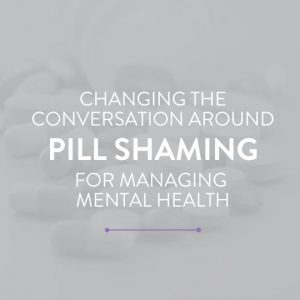
Healthcare providers and learners around the world are under extreme pressures due to the COVID-19 pandemic. Some of our colleagues may be suffering internally from depression, anxiety, suicidal thoughts, and alcohol use disorder, but still maintaining an external air of rationality and calm. How can we use clinical simulation to train ourselves to recognize, appreciate, and work through these challenges? Today’s guest authored an article by Kim LaMontagne MBA, an international speaker, teacher, and author who describes the lived experience of a high performing individual who lived in silence in the workplace with mental illness and substance use disorder. Here, she shares her journey on creating and sustaining a mentally healthy workplace culture and identifies key warning signs that we can utilize through medical simulation to educate and train for. Kim writes…
I was a leader, coach, trailblazer, high performer and someone people looked to for guidance. I exceeded goals, developed corporate partnerships, and won awards for my work. Outwardly, I looked like I had it all together.
But behind the mask, I carried a secret. Inwardly, I was broken, empty, ashamed, and unworthy. I was living with depression, anxiety, suicidal thoughts, and alcohol use disorder, yet still performing in the workplace. I was drowning but too afraid to ask for help because of fear, shame, and stigma. I feared being seen as weak and incapable, tarnishing my professional image, and losing my job or seat at the table. Those thoughts were all at the forefront of my mangled mind. How could I allow my colleagues to see the “real me” when I was seen as a mentor and leader? Consequently, I remained silent and suffered alone.
Depression is the inability to move past negative thoughts. Depression strips one’s ability to see themselves as worthy. Depression steals happiness and exchanges it for heaviness, fear, shame, sleepless nights, and physical pain. Depression is like being alone at the bottom of a 300-foot dark well that is greased up with no ladder to climb out. You feel alone, unsafe, unseen, and scared. I remained alone at the bottom of the well with my intrusive thoughts for years. Completely isolated and anxious and still performed in the workplace. I hid behind email and skype to hide the intensity of my emotions.
At my worst:
- I withdrew and only spoke when necessary. That was a sign.
- I missed deadlines. That was a sign.
- I performed in a more isolated capacity and stopped reaching out to co-workers. That was a sign.
- I stopped coming up with my “out of the box” ideas. That was a sign.
- I rescheduled or canceled meetings when the anxiety was too intense. That was a sign.
At a sales summit, I won the Director’s Choice award. It was a night to celebrate with colleagues. I got inebriated and didn’t notify my husband I had made it back to my hotel room safely. I overslept and learned the hotel had been evacuated the night prior because of a fire alarm. Everyone evacuated except me. I was passed out in my room. Thankfully, no one was physically hurt, but what was hurt was my dignity. But that was one of the final signs! I now see that through all of the above, I put my company, my family, and myself at risk for my behavior.
At 11 years sober and healthy, it is my responsibility to share my experience and what I have learned to give others the strength to ask for help, especially during trying times such as COVID 19. My story is not unique. What is unique is that I am sharing my lived experience with vulnerability in the hopes it will help and support others.
Healthcare Worker Mental Health is Suffering During the Pandemic
COVID 19 has affected the mental well-being of many of us, especially nurses and frontline workers. As such, I recently developed mental health questions for a Coronavirus National Nurse Wellbeing Survey conducted by FeedTrail and Holliblu in April 2020 which found that:
- 56% of nurses feel there is a stigma in the workplace around mental health
- 46% of nurses reported they are likely to leave their current position or specialty
- Of the nurses that responded to the question: Are you personally experiencing any of the following due to COVID-19;
- Anxiety (66%), emotional stress (62%), and lack of sleep (54%) were among the top selected factors.
- 50% of all respondents feel either unsafe or neutral when it comes to asking for mental health in the workplace.
- 78% of those that feel very unsafe to ask for mental health support in the workplace reported that are likely to leave their current position or specialty.
How We Can Use Healthcare Simulation to Relieve the Pressure
5 things I have learned by sharing my personal story and training organizational leaders about creating and sustaining a mentally healthy workplace culture:
- Employees struggling with mental health and substance use rarely feel their work environment is a place of safety. By opening the conversation about mental health in the simulation lab after challenging scenarios, you empower employees to speak their truth and remove blockages to peak performance.
- Often, employees are afraid to ask for support for fear of retribution or job loss. They survive behind a “mask” to hide the fear and shame. By fostering a climate of vulnerability in your simulation-based learning, you create a culture of transparency and open communication, resulting in a more engaged and healthier workforce/learner cohort
- Stigma and Discrimination thrive on a lack of knowledge and understanding. There are many misconceptions about mental illness and substance use which lead to stigma and discrimination. Educating employees with simulation in healthcare about mental health and substance use can create more open communication, understanding, and empathy.
- Individuals thrive when they are in a safe environment. Making one key shift in communication about mental health fosters a safe climate of vulnerability that supports employee health, wellness, engagement, and productivity. Just like we ask for a safe space to learn through simulation, we can use the same space for prompting wider conversations about mental health.
- Leaders lead by example, both in simulation and professional care settings. The most powerful organizational leaders make it possible for individuals to remove the mask of fear and shame and speak openly about mental health and well-being in the workplace. That is why gaining support for simulation training programs from key administrators and stakeholders, who also participate in the learning experiences, provides the strongest demonstration of investment to your colleagues or students.
As a mental health expert, Kim has witnessed many organizations struggling to provide tools to help support their mental well-being. As a solution, she has created The 4 Pillars of Creating and Sustaining a Mentally Healthy Workplace Culture.
This training for organizational leaders and employees addresses the impact of mental illness in the workplace and shares Kim’s experiences, helping to change the conversation about mental health. These powerful tools offer a way to remove the stigma of discussing mental health in healthcare, fostering an environment of safety and support during this challenging time. An environment where employees feel safe enough to come forward and ask for help!
Learn More About Kim’s
4 Pillars of a Mentally Healthy Workplace Culture Here!
Further Reading:
Laerdal: “Using Virtual Simulation to Support Mental Health Education” – Nurses are the largest group of professionals providing mental health care, whether it’s in primary or specialist health services. Because of nurses’ direct relationships with patients, it is critical that they feel confident in their ability to detect mental illness and treat patients accordingly. Nursing educators advocate for early and immersive mental health education at both the pre-licensure and graduate levels. Virtual simulation, a method of engaging students via eLearning, has increased in popularity because it can help to introduce mental health education in an interactive and realistic way. In fact, 65% of nursing programs are currently using virtual simulation. Through the use of virtual simulation, learners can fine-tune their assessment skills and improve their ability to recognize mental illness, both through the observable physiological changes and the patient interview.
Simulation benefits learners in this regard because it provides an opportunity to introduce less common events that may not be seen in a traditional clinical placement.14 Virtual simulation, specifically, is proven to be a consistent and effective method of training nurses. Research has shown that up to 60% better consistency of learning can be achieved through technology-based training.15 Each scenario requires learners to gather patient history and practice patient-centered care. The learning experience promotes the development of critical-thinking and decision-making skills, while also giving learners a “real life” experience with mental illness.
Simulation and mental health outcomes: a scoping review (Williams et al.): A scoping review was conducted in order to map and determine the gaps in the literature on the impact of simulation as an educational approach to improve mental health care outcomes. As it became apparent that no literature existed on this topic, the study aimed to examine the educational impact of simulation on mental health education. A total of 48 articles were included in this review, with a considerable portion of studies conducted in the USA and UK. Others were conducted in an array of locations including Australia, Canada, Iran, and Taiwan. Of the included articles, seven groups of simulation methods (including standardized patients, virtual reality, and manikins as patients) were evident, with standardized patients being most prominent.
Literature is lacking in evidence the benefit of simulation on mental health patient outcomes. However, the available literature suggests a variety of simulation-based education, and training methods are currently being used within mental healthcare education. The findings do suggest some methods of simulation, such as the use of SPs, are more commonly used in education and have been deemed as effective to assist in mental health education. As no article specifically examining the mental health outcomes of patients treated by health professionals taught by simulation was identified, the educational outcomes outlined in this paper may be used to inform further research, incorporating mental health patient outcomes.
to read the complete article please visit Healthy Simulation

You are invited to schedule a consult to learn how to shift the dialog about mental health and create a mentally healthy workplace culture where everyone feels safe asking for help.




